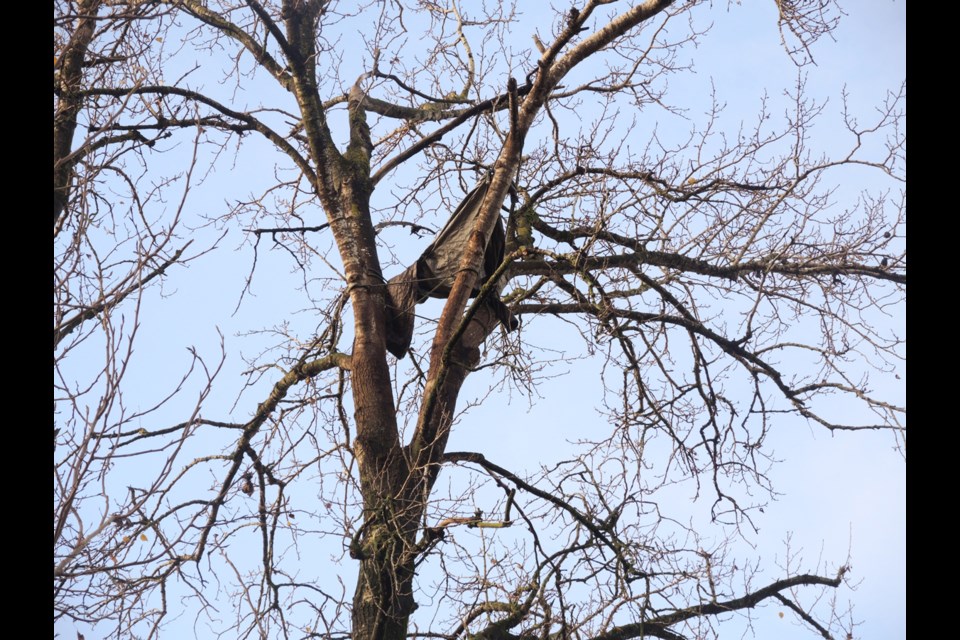The removal of a long-established bald eagle’s nest from a 90-foot tree in a Richmond neighbourhood was totally necessary, according to a local raptor expert.
Pairs of bald eagles are thought to have been nesting for about 20 years in the thick-set, cottonwood tree in the backyard of an older-style, detached home on Rosamond Avenue in west Richmond.
Local residents were, however, horrified last week when it became apparent that the nest was removed and a tarp was erected above the nesting fork to prevent the mating eagles from returning.
The Richmond News understands that the nest had to be removed after a neighbour of the property owner expressed safety concerns about the tree’s health.
The property owner then called in an arborist, who deemed the tree was, indeed, a hazard and should be removed.
A subsequent inspection by City of Richmond staff — after the homeowner had applied for a tree-removal permit — confirmed the tree had “significant structural defects” and was determined as “hazardous.”
With the tree condemned, the homeowner had to apply to the provincial Ministry of Forests, Lands and Natural Resource Operations for a permit to have the nest removed, once the nesting season was over.
“I’ve known about this nest for many years; the homeowner loved it and didn’t want to get rid of it; it’s been in his backyard for many, many years,” said David Hancock, renowned eagle biologist of 55 years and founder of the Hancock Wildlife Foundation, who is frequently consulted by the ministry for cases such as this.
“There were, understandably, insurance liabilities with the tree for the property owner, especially given the arborist report.
“(The ministry) called me; it was me that insisted this nest be taken away now because, if they took it away between January and March, it’d be too late for the eagles to find a new nest.
“This way, the eagles have time to find a new location and build a new nest, which takes about three weeks.
“Nobody wants to lose an eagle’s nest, especially me, but when this kind of thing happens, it’s the responsible thing to do.”

Eagles are known to have a “secondary nest” and, although it’s not known if this pair of eagles has one, Hancock said they may be able to nest at the nearby Quilchena Golf Club.
“There are possibilities at the north end of the golf course,” Hancock told the News.
There’s already an eagle’s nest at the southern end, added Hancock, “so if the north location is 400 to 500 yards away, they might be able to go there. That’s roughly how far away it needs to be (for territorial reasons).”
Hancock’s foundation has eyes on 412 active eagle’s nests in the region, from West Vancouver to Tsawwassen and White Rock and as far east as Chilliwack and Harrison Mills.
Local resident Judy Arnold told the News of her sadness at realizing the eagles nest was no more.
“I think it could have been delayed for at least another year or so,” she said.
“This was their primary nest and the eagle was back there today (Monday), clearly looking for its nest. I’m sure more could have been done to save this nest.”
It’s understood that the tree was starting to shed some of its major branches, alerting the owners of the neighbouring property to have it inspected.
The News attempted to speak directly with the wildlife officer, who removed the nest, but was directed to a ministry spokesperson, despite the fact the officer is allowed to field questions from the general public.
A spokesperson for the ministry said it was made of aware in August of the need to have the nest removed due to the tree’s failing condition.
“The removal of the nest was permitted with the safety and with the best in mind for the eagles. They will now have an opportunity to find an alternate nest…,” read the statement.
“The tree is a cottonwood, which unfortunately are not long lived. These trees tend to grow up quickly, however, they are very susceptible to rot and decay, as noted in the arborist report.”
Asked about the knowledge of a secondary nest, the ministry said that, “Generally raptors have a secondary nest, however we have no confirmed secondary nest for this pair.”
Cindy Lee, founder of Facebook group Save Richmond’s Trees, said she felt “terrible” and “upset” about the removal of a “perfectly good, well-established eagle’s nest.”
“We’ve lost so many trees in Richmond and we’re losing our wildlife at the same time,” said Lee, casting doubts on the tree’s condemnation, although acknowledging she has no specific, arborist qualifications or expertise.
No-one answered the door of the Rosamond Avenue property in question when the News called on Wednesday.
It’s understood the tree is going to be taken down before January.



